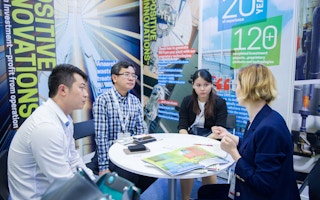Switch on the lights in your home in the future and there could be a good chance that the electricity comes from wood chips, used tyres and other biological and municipal wastes that have been converted into energy sources.
ETIA, a French engineering company that specialises in transforming waste and biomass into electricity and biofuels, is planning to expand its operations in Southeast Asia after enjoying success in markets in Europe, North America, the Middle East, Asia and Africa.
It is one of 35 European companies that will be showcasing their innovative green energy technologies in Singapore and Malaysia this week, as part of a week-long business mission organised by the European Union (EU).
This Green Energy Technologies business mission is part of the Union’s new EU Business Avenues in South East Asia programme. Launched in June, the initiative aims to bring up to 1,000 European small and medium enterprises (SMEs) on week-long trips to Southeast Asia over the next five years to help them to develop their businesses outside of Europe.
“This trip to Singapore and Malaysia will allow the European SMEs and their counterparts in the region to explore new collaborations and growth opportunities in the green energy sector,” says Dr. Michael Pulch, the EU Ambassador to Singapore.
“
We see big opportunities for our technology in Southeast Asia, especially in turning biomass residues into bio-coal and electricity, and in turning municipal solid waste into electricity, especially for small off-grid power plants.
Olivier Lepez, president, ETIA
Unlocking waste’s full potential
ETIA’s technologies could help Southeast Asian countries to deal with their growing waste by converting more of it into electricity and biological fuels, thereby reducing their need for landfills and increasing their use of renewable energy at the same time.
The firm’s Biogreen systems can use a wide variety of waste as feedstock, including wood chips and sawdust, animal manure, sewage and industrial sludge, plastics and used tyres. The waste is heated in an oxygen-free chamber to produce charcoal and gases, and some of the gases are also condensed to produce oil.
“We are particularly interested in Southeast Asia because it generates a huge quantity of biomass residues from palm oil activities,” says ETIA president Olivier Lepez.
Malaysia and Indonesia alone account for about 90 per cent of global palm oil production. “There is a huge potential market for solutions that can turn the waste from those activities into electricity.”
ETIA offers its Biogreen systems in the form of both stationary plants and mobile, containerised units. The fixed plants have lower investment costs but require more space, while the mobile units better suited to quick and temporary deployments, for example, if the intended project area has limited space or restrictions on new building works.
ETIA has installed 30 Biogreen systems in 15 countries, including Japan, Malaysia and Indonesia. These can process up to 3,000 kg of waste per hour.
It also has research and development centres in the United States and France that are working on more waste management technologies, such as waste-to-hydrogen systems, and is open to collaborating with partners in Southeast Asia to establish similar centres in the region.
“We see big opportunities for our technology in Southeast Asia, especially in turning biomass residues into bio-coal and electricity, and in turning municipal solid waste into electricity, especially for small off-grid power plants,” says Lepez.
Solar on the sea
Austrian company Swimsol, meanwhile, has its eyes set on Southeast Asia’s solar power sector. The firm, which has more than two decades of experience in installing rooftop solar panel systems, recently expanded its offerings to include floating solar panel systems for tropical regions.
“Southeast Asia has many land-scarce islands, coastal cities and remote coastal areas where space is a precious resource,” explains Thomas Siebenbrunner, Swimsol’s head of sales and marketing. “Our technology enables unlimited solar power generation by using the abundant sea surface for solar panels.”
Furthermore, many coastal regions in Malaysia and throughout Southeast Asia currently depend on diesel generators for power generation. Swimsol’s technology can provide a clean alternative energy source, says Siebenbrunner.
To create solar panels that will not corrode in humid and salty environments, the firm searched for high-quality components, subjected them to independent tests that included testing how they worked under long-term damp heat and salt mist corrosion. It selected the most resilient ones, then developed a way to seal these panels to further prevent corrosion.
“We use heavy-duty, high performance panels developed specifically for tropical marine regions, and our systems have a lifetime of about 30 years,” says Siebenbrunner.
Swimsol’s floating solar panel systems have been installed in various locations in the Maldives so far. One system located at the Baa Atoll is expected to help a local island save more than 50,000 litres of diesel annually and reduce its carbon dioxide emissions by more than 130 tonnes per year on average for the next 30 years.
The firm also recently opened an office in Jakarta, Indonesia, to cater to the Southeast Asian market.
Forging East-West partnerships
This week, representatives from 35 European firms will share more about their technologies, which also includes wind power and energy conservation systems, at the Marina Bay Sands Expo and Convention Centre as part of the Singapore International Energy Week, before they travel to Kuala Lumpur for pre-arranged business meetings.
“Southeast Asia is a rapidly growing market that has much untapped economic potential, particularly for SMEs,” says Pulch, the EU Ambassador.
“The companies selected for this business mission have strong value propositions for the energy sector in Southeast Asia, and we hope they will form long-lasting business collaborations with their counterparts in the region.”
The companies will showcase their green energy technologies at the Asia Clean Energy Summit 2016 Conference and Exhibition at the Marina Bay Sands Expo and Convention Centre on Oct 25 and 26. The summit is part of the Singapore International Energy Week.











